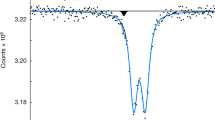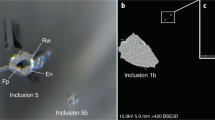Abstract
Cubic diamonds from Zaire show excellent correlations between potassium content and 40Ar/36Ar ratio, and between 40Ar/36Ar and 39Ar/36Ar, which can be interpreted to yield an 'isochron' age of about 6 Gyr. Now the discovery of a correlation between chlorine content and 40Ar, together with recent mineralogical and geochemical work concerning the origin of cubic diamonds, strongly suggests that the 40Ar is an excess component which has no age significance, and that the 40Ar and its associated potassium are contained in sub-micrometre inclusions of mantle-derived fluid.
This is a preview of subscription content, access via your institution
Access options
Subscribe to this journal
Receive 51 print issues and online access
$199.00 per year
only $3.90 per issue
Buy this article
- Purchase on Springer Link
- Instant access to full article PDF
Prices may be subject to local taxes which are calculated during checkout
Similar content being viewed by others
References
Zashu, S., Ozima, M. & Nitoh, O. Nature 323, 710–712 (1986).
Akagi, T. & Masuda, A. Geochem. J. 22, 81–82 (1988).
Podosek, F. A., Pier, J., Nitoh, O., Zashu, S. & Ozima, M. Nature 334, 607–609 (1988).
Navon, O., Hutchcon, I. D., Rossman, G. R. & Wasserburg, G. J. Nature 335, 784–789 (1988).
Boyd, S. R. et al. Earth planet. Sci. Lett. 86, 341–353 (1987).
Alexander, E. C. Jr, Michelson, G. M. & Lanphere, M. A. US geol. Surv. Open File Rep. 78–701, 6–8 (1978).
Ozima, M. & Zashu, S. Earth planet. Sci. Lett. 62, 24–40 (1983).
Ozima, M. & Zashu, S. Geochim. cosmochim. Acta 52, 19–25 (1988).
Turner, G. Geochim. cosmochim. Acta 52, 1443–1448 (1988).
Hiyagon, H. & Ozima, M. Geochim. cosmochim. Acta 50, 2045–2057 (1986).
Hart, R., Dymond, J. & Hogan, L. Nature 278, 156–159 (1979).
Kaneoka, I. & Takaoka, N. Science 208, 1366–1368 (1980).
Manuel, O. K. & Sabu, D. D. Geochem. J. 15, 245–267 (1981).
Allègre, C. J., Staudacher, T., Sarda, P. & Kurz, M. Nature 303, 762–766 (1983).
Marty, B. & Jambon, A. Earth planet. Sci. Lett. 83, 16–26 (1987).
O'Nions, R. K. & Oxburgh, E. R. Earth planet. Sci. Lett. (in the press).
Roddick, J. Geochim. cosmochim. Acta 47, 887–898 (1983).
Kelley, S., Turner, G., Butterfield, A. W. & Sheppherd, T. J. Earth planet. Sci. Lett. 79, 303–318 (1986).
Author information
Authors and Affiliations
Rights and permissions
About this article
Cite this article
Ozima, M., Zashu, S., Takigami, Y. et al. Origin of the anomalous 40Ar—39Ar age of Zaire cubic diamonds: excess 40Ar in pristine mantle fluids. Nature 337, 226–229 (1989). https://doi.org/10.1038/337226a0
Received:
Accepted:
Issue Date:
DOI: https://doi.org/10.1038/337226a0
This article is cited by
-
Volatile-rich mantle fluids inferred from inclusions in diamond and mantle xenoliths
Nature (1990)
-
Diamond dating anomalies
Nature (1989)
Comments
By submitting a comment you agree to abide by our Terms and Community Guidelines. If you find something abusive or that does not comply with our terms or guidelines please flag it as inappropriate.



